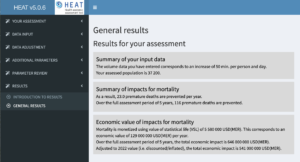Health Impacts of Active Transportation
Active transportation improves health outcomes. Active transportation both reduces air pollution in cities and provides health co-benefits to individuals. Walking and cycling can integrate physical activity into daily life reducing chronic conditions such as diabetes and cardiovascular disease.
Active transportation has positive environmental effects, especially if cycling and walking replace short car trips. Active transportation planning provides immediate benefits to communities by reducing air pollution from vehicle traffic and improves climate change outcomes in the long term. Transportation policy can be used as a tool to benefit health.

Building Enjoyable Walking and Biking Spaces
Building infrastructure that makes active transportation enjoyable is one of the most important investments that city planners can make in air quality. If city streets are comfortable and safe community members are much more likely to use active and public transportation. The goal is to make walking and cycling enjoyable activities.
Increasing protected cycling lanes and increasing green space can make active transportation a more relaxing experience. The Health Economic Assessment Tool (HEAT) tool helps city planners assess the health benefits to their own communities.
Using HEAT for assessing transportation planning
The Health Economic Assessment Tool (HEAT) is an evidence-based useable tool that allows transportation planners to factor health benefits into transport economic assessments. This tool will work for most communities and while it was developed for transportation planners, it has also been useful to other professional specialties such as health economists who are interested in reducing health care costs. HEAT has been thoroughly vetted through consensus and has been used in at least thirty scientific publications. Since its launch in 2014, it has been used by over a million users.
Results from HEAT generally display like this, with specifics of your use case:

Though it’s difficult to assess at this point the role this tool has on policy changes, HEAT is often used as one point in a larger political debate. One nice feature of the tool is that while there are many variable fields to improve the specificity of the community model, you only need two variables to get useful information from it. The two main input variables that you need are the communities transportation numbers and the size of the overall population. If you’d like to try it out with a general set of parameters, input a population of 200,000 people and 10min of cycling, then explore it again with parameters from your own community.
Examples of the cities that have used HEAT tool to improve active transit in cities include Barcelona, Trikala, and the Netherlands. In Barcelona, a study concluded that “changes in transport policies in Barcelona aimed at promoting active transportation created clear health benefits related to physical activity, but increased neither the number of pedestrian nor cyclist traffic injuries. Thus, under the framework of the Health in All Policies, the benefits of active travel support the need for better integration and coordination between transport and health policies.”
Bicycle traffic measurements recorded in Trikala, Greece demonstrate how and how much the increase in bicycle traffic in the future can increase life expectancy and reduce health care costs, thus being a beneficial investment. And while the Netherlands is well known for its high bicycle use, this study qualifying the health and economic benefits of cycling confirmed that investments in bicycle-promoting policies (e.g., improved bicycle infrastructure and facilities) will likely yield a high cost-benefit ratio in the long term.
Try it out
While the HEAT tool has been used in Europe more than in other regions, it will benefit transportation and city planning broadly in other regions of the world as well. There are new features upcoming as the HEAT tool. It gets improved as more users apply it, such as the HEAT team is currently finalizing an updated version and adding an eBike module to it. If your city or region is interested in assessing how much or which kinds of active transit might benefit your community, try out the HEAT tool.